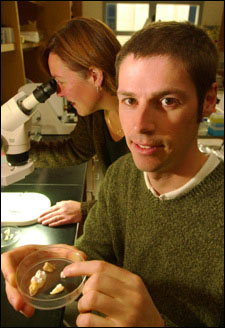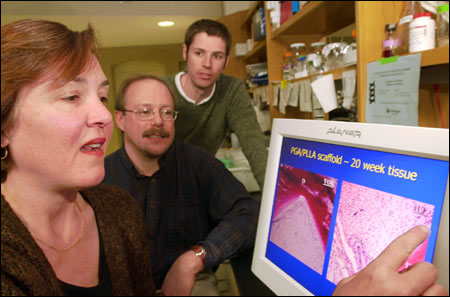Teething for adults in foreseeable future:
Research team grows teeth in the laboratory

Wondering whether to choose a bridge or an implant to fill that unsightly gap in your pearly whites? If you’re willing to wait a few years, you may have another option – growing your own.
Regrowing missing teeth may someday be a possibility, based on work by a team of scientists at the Forsyth Institute, an independent, Harvard-affiliated research organization specializing in oral and craniofacial biology.
Pamela Yelick, an assistant staff member at the Forsyth Institute and an instructor in oral and developmental biology at the Harvard School of Dental Medicine, says that the research she and her colleagues have carried out should result in a clinical product in about 15 years.
“Or maybe sooner. That’s probably a pretty conservative estimate,” Yelick said.
What Yelick and her co-workers, John Bartlett and Conan Young, have accomplished is to use tissue engineering processes to produce the first ever complex tooth crowns. Although they had reason to believe the experiment would be successful, the results were better than they anticipated.
“That first tooth was a wonderful discovery, a revelation,” said Young, instructor in oral and developmental biology. “The most surprising thing was that we got enamel.”
The team did not realize that the tiny tooth crown they had produced consisted of a core of dentin encased in a layer of enamel until they attempted to take a shaving of it to examine under a microscope. When they did, the blade on the slicing machine chipped.
“Tooth enamel has a hardness level somewhere between iron and carbon steel,” said Bartlett, an associate staff member at Forsyth and an assistant professor of oral and developmental biology. “We had no idea we had something that would break the blade.”
The successful tissue engineering experiment was reported in an article by Yelick and her colleagues in the Oct. 1 issue of the Journal of Dental Research.
Bruce Donoff, dean of the Dental School, calls the experiment “very exciting work, not only for the product that may come out of it but for what will be learned along the way about tissue interactions. Something very right is happening in this system, and we’re glad to be a part of it.”
Donoff’s excitement about the project is based at least in part on the fact that it promises to fulfill the goal adopted by the Dental School’s Craniofacial Tissue Engineering Center – to produce a synthetic tooth. The Forsyth project was sponsored in part by seed money from the center.

The lab-grown tooth crowns, while only about 2 millimeters in diameter (the size of this capital O), are highly organized in structure, possessing the beginning of cusps and a structure known as Hertwig’s root sheath, features typical of naturally grown teeth.
They were grown from tooth buds taken from 6-month-old pigs and placed on biodegradable polymer scaffolds. These were then implanted in the omentum of rats, the fatty, blood vessel-rich tissue that surrounds the intestines, and that helped to stimulate the growth of the teeth. After 20 to 30 weeks, the teeth were removed.
“It was a long wait, not knowing if we’d get results,” said Young.
The team had reason to believe their experiments would be successful because they were using methods developed by Professor of Surgery Joseph Vacanti, a pioneer in tissue engineering and director of the Laboratory for Tissue Engineering and Organ Fabrication at Massachusetts General Hospital. The researchers had heard Vacanti talk about his experiments with regenerating intestine and liver tissues and began wondering whether they could apply his methods to their own field.
“It got us thinking, how could we apply Vacanti’s techniques to teeth. They’re very different, but the cell interactions are very similar,” said Young.
Both Vacanti and the Forsyth team used a polymer scaffold, a specially designed sponge-like structure that provides the cells with a form on which to grow. And both research teams work with stem cells, those elusive and mysterious entities that are at the center of so much cutting-edge research in biology these days.
Stem cells are undifferentiated cells and are responsible for cell renewal. When they divide, one daughter cell becomes a specialized cell and the other becomes another stem cell. One problem the Forsyth team faces is locating and isolating tooth stem cells.
Using special antibodies known to recognize human stem cells, the researchers will search for the two types of stem cells responsible for forming dentin and enamel. Once they have solved the stem cell problem, they will no longer be limited to growing teeth from tooth buds that have been removed from a living animal.
What makes this search particularly difficult is that they don’t know exactly where to look. Tooth stem cells might be located anywhere in the body. They might be circulating in the blood supply, a possibility that the researchers hope is the case since in order to harvest tooth stem cells they would simply have to take a blood sample.
Another mystery the team must work out is the nature of the cell-to-cell interactions that take place when a tooth is developing. These interactions play a key role in determining the size and shape of the tooth. And before teeth can be grown to order to replace the ones that have been lost, the problem of producing a new root must be solved. The team believes the root may be formed through interactions between the cells that make up the tooth and the bone cells that comprise the jaw.
“Right now, the amount that we don’t know is greater that what we do know,” said Bartlett. “The people who are trying to grow other types of tissues are way ahead of us. But you have to remember that the tooth is really an organ – it’s more complex, it has its own challenges, and, well … so far, so good.”




